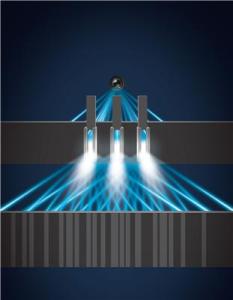Jul 23 2010
When waves - regardless of whether light or sound - collide, they overlap creating interferences.
Austrian and Canadian quantum physicists have now been able to rule out the existence of higher-order interferences experimentally and thereby confirmed an axiom in quantum physics: Born's rule. They have published their findings in the scientific journal Science.
 Gregor Weihs - Professor of Photonics at the University of Innsbruck -and his team are investigating new light sources to be used for transmitting quantum information.
Gregor Weihs - Professor of Photonics at the University of Innsbruck -and his team are investigating new light sources to be used for transmitting quantum information.
In quantum mechanics many propositions are made in probabilities. In 1926 German physicist Max Born postulated that the probability to find a quantum object at a certain place at a certain time equals the square of its wave function. A direct consequence of this rule is the interference pattern as shown in the double slit diffraction experiment. Born's rule is one of the key laws in quantum mechanics and it proposes that interference occurs in pairs of possibilities. Interferences of higher order are ruled out. There was no experimental verification of this proposition until now, when the research group led by Prof. Gregor Weihs from the University of Innsbruck and the University of Waterloo has confirmed the accuracy of Born's law in a triple-slit experiment. "The existence of third-order interference terms would have tremendous theoretical repercussions - it would shake quantum mechanics to the core," says Weihs. The impetus for this experiment was the suggestion made by physicists to generalize either quantum mechanics or gravitation - the two pillars of modern physics - to achieve unification, thereby arriving at a one all-encompassing theory. "Our experiment thwarts these efforts once again," explains Gregor Weihs.
Triple-slit experiment
Gregor Weihs - Professor of Photonics at the University of Innsbruck - and his team are investigating new light sources to be used for transmitting quantum information. He developed a single-photon source, which served as the basis for testing Born's rule. Photons were sent through a steel membrane mask which has three micrometer sized slits cut into it. Measurements were performed with the slits closed individually resulting in eight independent slit combinations. The data taken was then used to calculate whether Born's rule applies. "In principle, this experiment is very simple," says Gregor Weihs "and we were quite surprised to find that nobody hadn't performed this experiment before." However, the physicists were struggling with measurement errors, which they were eventually able to overcome during their two year long Sisyphean task. "Our measurements show that we can rule out the existence of third-order interference up to a certain bound," says a happy experimental physicist Weihs. His next step will be to considerably lower the bound with an improved experiment.
Master of light particles
The experiment was performed at the Institute for Quantum Computing at the University of Waterloo in Canada, where Prof. Gregor Weihs worked before his appointment at the University of Innsbruck. Since 2008 he has been setting up his own research group at the Institute for Experimental Physics in Innsbruck, which now comprises twelve group members. The group, whose members come from all over the world, investigates the development of novel single-photon sources and entangled photon pairs from semiconductor nanostructures. The researcher's ultimate goal is to integrate quantum optical experiments with functions on semiconductor chips.
Source: http://www.uibk.ac.at/